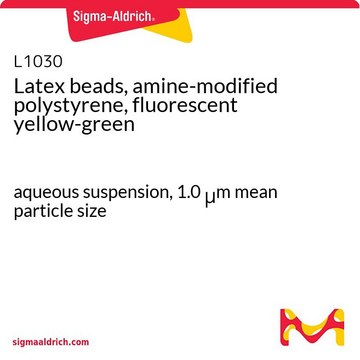P6407
Poly-ᴅ-Lysine Hydrobromide
synthetic, mol wt 70,000-150,000, powder, γ-irradiated, suitable for cell culture, BioXtra
Synonym(s):
PDL
About This Item
Recommended Products
product name
Poly-D-lysine hydrobromide, mol wt 70,000-150,000, lyophilized powder, γ-irradiated, BioReagent, suitable for cell culture
biological source
synthetic (organic)
Quality Level
sterility
γ-irradiated
product line
BioReagent
BioXtra
form
lyophilized powder
mol wt
70,000-150,000
packaging
pkg of 10 X 5 mg
pkg of 5 mg
concentration
0.016—0.032 mmol lysine
technique(s)
cell culture | mammalian: suitable
surface coverage
4 μg/cm2
impurities
<10% water (by Karl Fischer)
solubility
H2O: soluble 50 mg/mL, clear, colorless
shipped in
ambient
storage temp.
−20°C
SMILES string
O=C(C)[C@@](NC)([H])CCCCN.[Br]
InChI
1S/C6H14N2O2.BrH/c7-4-2-1-3-5(8)6(9)10;/h5H,1-4,7-8H2,(H,9,10);1H
InChI key
MEXAGTSTSPYCEP-UHFFFAOYSA-N
Looking for similar products? Visit Product Comparison Guide
Application
- as a coating for plates used in culturing rat glial precursor cells (RGPCS).
- in coating flasks and plates in culturing tanycytes
- in preparing the surface of coverslips for facilitating cell attachment
This product is recommended as a cell culture substratum when using 0.5 - 1.0 mL of a 0.1 mg/mL solution to coat 25 cm2. Lower molecular weight versions of the product are less viscous, but high more molecular weight versions provide more attachment sites per molecule.
Biochem/physiol Actions
Features and Benefits
- Sterilized using gamma (γ) radiation.
- Sterile Poly-D-Lysine solutions can be stored for three years when stored at 2-8˚C.
Components
Caution
Preparation Note
comparable product
Storage Class Code
11 - Combustible Solids
WGK
WGK 3
Flash Point(F)
Not applicable
Flash Point(C)
Not applicable
Personal Protective Equipment
Certificates of Analysis (COA)
Search for Certificates of Analysis (COA) by entering the products Lot/Batch Number. Lot and Batch Numbers can be found on a product’s label following the words ‘Lot’ or ‘Batch’.
Already Own This Product?
Find documentation for the products that you have recently purchased in the Document Library.
Customers Also Viewed
Articles
Poly-Lysine enhances electrostatic interaction between negatively-charged ions of the cell membrane and positively-charged surface ions of attachment factors on the culture surface. When adsorbed to the culture surface, it increases the number of positively-charged sites available for cell binding.
Cancer stem cell media, spheroid plates and cancer stem cell markers to culture and characterize CSC populations.
Extracellular matrix proteins such as laminin, collagen, and fibronectin can be used as cell attachment substrates in cell culture.
Protocols
Polyamino acids facilitate the attachment of cells and proteins to solid surfaces in biological applications. In cell cultures normal attachment, growth, and development of many cell types are dependent on attachment factors and extracellular matrix components.
Our team of scientists has experience in all areas of research including Life Science, Material Science, Chemical Synthesis, Chromatography, Analytical and many others.
Contact Technical Service







